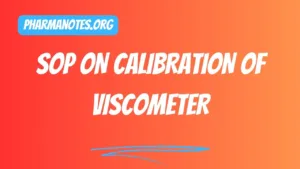Calibration of Viscometer (Oscillatory)

SOP on Calibration of Viscometer (oscillatory)
1.0 PURPOSE
The purpose of the standard operating procedure is to provide guidelines for calibration of Viscometer (oscillatory).
2.0 SCOPE
The scope of this standard operating procedure includes calibration of Viscometer (oscillatory).
3.0 RESPONSIBILITY
3.1 Section Incharge
3.2 Technical Manager
3.3 Q.A. Manager
4.0 PROCEDURE
4.1 Switch on the instrument.
4.2 Using the standard operating conditions start the operations of the instrument.
4.3 Select the proper spindle number i.e. L1, L2, L3, L4 depending upon the range of viscosity to be determined and attach to the viscometer.
4.4 Ensure that the spindles are cleaned before and after use.
4.5 Select the proper speed in RPM depending upon the range of viscosity to be determined.
4.6 Control the temperature of the sample at which the viscosity is to be determined.
4.7 Immerse the spindle in the sample container up to the set point mark. The spindle should not touch the container in any way.
4.8 Start the instrument at the selected speed and record the viscosity in cps units.
4.9 Change the speed of the spindle and record the viscosity in cps units.
4.10 The viscosity should not differ with change in the speed of the spindle.
4.11 Correlate the observed values of viscosity with the stated values of the reference standard and make adjustments, if necessary.
FAQs on Calibration of Viscometer
- How often should viscometers be calibrated?
Calibration frequency depends on instrument stability, analytical requirements, and regulatory standards. Typically, viscometers are calibrated at regular intervals, ranging from daily to annually.
- What are the consequences of inadequate calibration in viscometry?
Inadequate calibration can lead to inaccurate measurements, compromised data integrity, and regulatory non-compliance. It may also result in erroneous conclusions, product recalls, and financial losses.
- What are some common challenges encountered during viscometer calibration?
Common challenges include instrument variability, temperature fluctuations, and errors in sample preparation. Addressing these challenges requires thorough understanding, proper training, and adherence to best practices.
- How can laboratories ensure compliance with regulatory requirements for viscometer calibration?
Laboratories must familiarize themselves with relevant regulatory guidelines and standards, establish robust calibration protocols, and maintain comprehensive documentation. Regular audits and inspections can help ensure ongoing compliance.
- What are the future trends in viscometer calibration?
Future trends may include automation and robotics, miniaturization and portability, and data integration and connectivity. These trends aim to enhance efficiency, accuracy, and accessibility in viscometer calibration practices.
Also, Visit:
B. Pharma Notes | B. Pharma Notes | Study material Bachelor of Pharmacy pdf